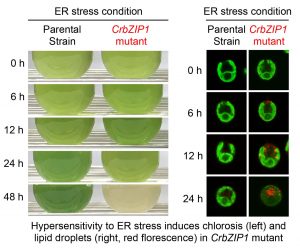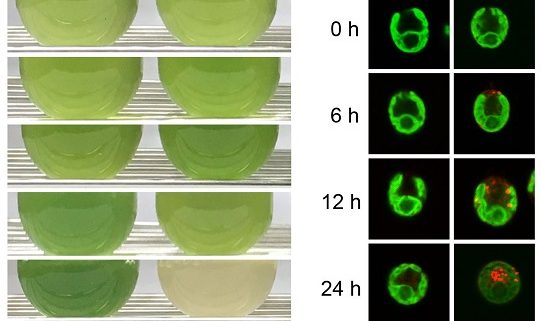How a Plant Plankton Copes with Stress
Yamaoka et al. report that the mRNA of a Chlamydomonas bZIP transcription factor is spliced by CrIRE1 under ER stress, and the resulting protein protects cells via modulating lipid remodeling. Plant Cell https://doi.org/10.1105/tpc.18.00723
By Yasuyo Yamaoka and Youngsook Lee
Background: The endoplasmic reticulum (ER) is a compartment in a cell where secretory and membrane proteins are synthesized and folded. A variety of stress conditions that disturb folding of proteins in the ER triggers the accumulation of unfolded proteins inside of the ER, causing the ER stress. Chlamydomonas reinhardtii is a model microalga widely used for studies of photosynthesis, flagella biogenesis, and lipid metabolism. Previously we found that ER stress sensor CrIRE1 regulates ER stress response in Chlamydomonas. However, very little is known about the downstream processes of ER stress response, and not much at all on how membrane lipids respond to the stress in Chlamydomonas.
Question: What protein and lipid factors regulate ER stress response in Chlamydomonas? How do they regulate ER stress response? Does ER stress induce any change in membrane lipids in Chlamydomonas cells? Does the lipid change induced by ER stress contribute to ER stress resistance?
 Findings: We found that a transcription factor CrbZIP1 is necessary for normal ER stress response mediated by CrIRE1 in Chlamydomonas. Chlamydomonas mutants deficient in CrbZIP1 cannot express the ER stress response genes and grow poorly under ER stress. CrbZIP1 directly activates expression of enzymes catalyzing the biosynthesis of diacylglyceryltrimethylhomo-Ser (DGTS) and pinolenic acid, which are a ER-localizing membrane lipid and polyunsaturated fatty acid, respectively, resulting in increase of DGTS and pinolenic acid under ER stress. Moreover, Chlamydomonas mutants that failed to synthesize pinolenic acid were more sensitive to ER stress than their parental lines. Together, our findings indicate that CrbZIP1 serves as a critical factor in ER stress resistance in Chlamydomonas by remodeling cellular lipids.
Findings: We found that a transcription factor CrbZIP1 is necessary for normal ER stress response mediated by CrIRE1 in Chlamydomonas. Chlamydomonas mutants deficient in CrbZIP1 cannot express the ER stress response genes and grow poorly under ER stress. CrbZIP1 directly activates expression of enzymes catalyzing the biosynthesis of diacylglyceryltrimethylhomo-Ser (DGTS) and pinolenic acid, which are a ER-localizing membrane lipid and polyunsaturated fatty acid, respectively, resulting in increase of DGTS and pinolenic acid under ER stress. Moreover, Chlamydomonas mutants that failed to synthesize pinolenic acid were more sensitive to ER stress than their parental lines. Together, our findings indicate that CrbZIP1 serves as a critical factor in ER stress resistance in Chlamydomonas by remodeling cellular lipids.
Next steps: Microalgae are promising candidate organisms for many useful products, but various stresses reduce cell growth and productivity in algal cell culture. Our work identified genes that are critical for ER stress resistance of microalgal cells, providing molecular tools for engineers to design stress-resistant microalgal cell factories.
Yasuyo Yamaoka, Seungjun Shin, Bae Young Choi, Hanul Kim, Sunghoon Jang, Masataka Kajikawa, Takashi Yamano, Fantao Kong, Bertrand Légeret, Hideya Fukuzawa, Yonghua Li-Beisson, Youngsook Lee. (2019). The bZIP1 Transcription Factor Regulates Lipid Remodeling and Contributes to ER Stress Management in Chlamydomonas reinhardtii. Plant Cell. https://doi.org/10.1105/tpc.18.00723.
Key words: Microalgae, ER stress, Lipid, Pinolenic acid




